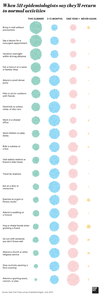When we’ll return to these ‘normal’ activities, according to experts
Epidemiologists answer your burning questions.

Follow all of PopSci’s COVID-19 coverage here, including tips on cleaning groceries, ways to tell if your symptoms are just allergies, and a tutorial on making your own mask.
Many Americans are clamoring to get back to normal life, whether the novel coronavirus is gone or not (and it most certainly is not). The banal hallmarks of everyday life—hair cuts! restaurants! physical human contact!—seem pretty tempting after more than three months of varying degrees of isolation.
Now is, unfortunately, not the time to get back to all of that, at least in the US. We haven’t yet gotten COVID under control. Cases are surging yet again in many states, and some places are now reversing some of their reopening steps in an effort to curb the growth. So, more people than ever are probably wondering: when the heck am I going to be able to live my normal life again?
For those of us who don’t know any epidemiologists to ask personally, the New York Times questioned 511 of them about when they would consider returning to a slate of normal activities. Some were extremely cautious (a few said they may never shake another person’s hand again) and others were cautiously optimistic (one epidemiologist told the Times that they were looking forward to dating again). Together, their responses can give us some guidance about when we might expect to have some semblance of normality again.
Here’s what they said:

Of course, all of this is dependent on how much we can control the spread of virus. If we continue to flaunt mask-wearing guidelines and social distancing recommendations, these timelines could easily get pushed out even farther. If we all do our part, they could come sooner. Life has largely returned to normal in the handful of countries, like New Zealand, that took early, decisive action against COVID. We’ll need to do a lot more testing, tracing, and working to slow transmission down if we want to follow in their footsteps.